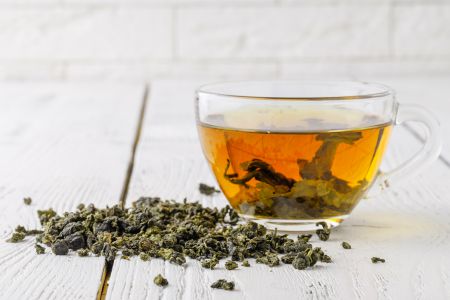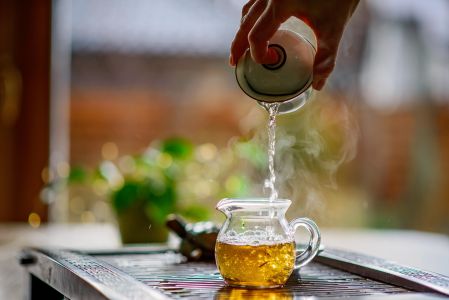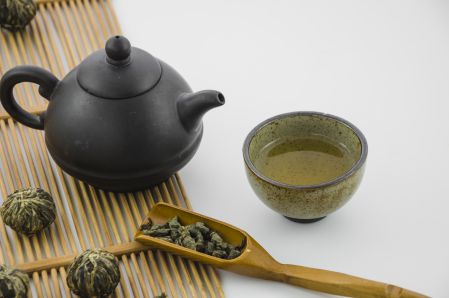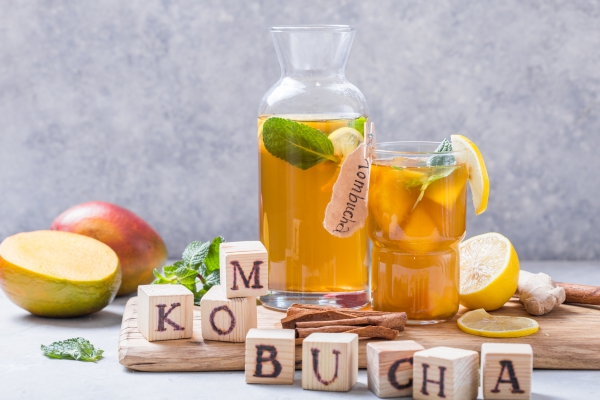Oolong tea is a well-known traditional beverage of China and Taiwan made up from the buds, leaves and branches of camellia sinensis plant. It is well known for its characteristic flavor and unique health benefits
Characteristic
- The color of oolong tea leave is generally green, but it is varying from green to golden and golden to brown
- It has seen that oolong tea along with catechin and caffeine show significant role on eradicating free radicals
- There are basically three types of oolong tea found, which include iron goddess, wuyi rock oolong tea and dong ding oolong tea
- It undergoes partial oxidation during its processing
- Oolong teas are basically available in the form of thin strand or tight balls. Rolling, curling and twisting of oolong teas are responsible for this artisanal shaping
Nutritional overview
- It does not provide a lot of calories as it contains very less or no carbohydrates and fats. Hence it is considered as a low-calorie beverage
- It contains an important amino acid named theanine
- It is packed with various essential micronutrients such as fluoride, sodium, potassium, magnesium, manganese and B vitamins especially niacin
- It also contains several biologically active components responsible for exerting antioxidant, anti-inflammatory, antiseptic activities, which include caffeine, polyphenolic compounds, epigallocatechin gallate, theaflavins, thearubigins

Oolong tea vs. green tea
Both types of tea are originated from the same plant (sinensis plant) and almost have same health benefits, but they differ from each other because of their processing techniques. Below points will confer a comparative discussion between oolong tea and green tea –
- Oolong tea is fermented and partially oxidized during its processing, but the processing of green tea does not involve oxidation
- Green tea contains comparatively higher amount of antioxidant than oolong tea
- Oolong tea contains lesser number of polyphenols and catechins than green tea
- Whereas the caffeine content of oolong tea is to some extent higher than green tea
- Oolong tea is relatively more beneficial than green tea for reducing weight
- Oolong tea has more astringency than green tea
- Oolong tea can be consumed with meal, but consumption of green tea with meal is not good for health as it may develop various gastrointestinal problems
Health benefits
Role on preventing cancers
- Consumption of oolong tea helps to decrease the prevalence of cancers by preventing cell mutation
- Polyphenolic components of oolong tea show significant anti-carcinogenic effects and reduce the rate of malignant cell division
- It is related with decreasing the risk of developing pancreatic, liver, esophageal, colorectal and lung cancers

Role on improving brain functions
- It is associated with increasing the secretion of dopamine and nor-epinephrine that help to improve the functionality of brain
- It has seen that consumption of oolong tea is closely related with improving cognition and memory
- It also facilitates executive functions as well as increases information processing speed
- It helps to prevent Alzheimer’s disease and Parkinson’s disease

Role on mental health
- Polyphenolic components of oolong tea are responsible for exerting a calming effect that helps to reduce anxiety, depression and stress
- Theanine and caffeine components of oolong tea help to increase attention and alertness
- Consuming oolong tea is also associated with enhancing mood
Role on oral health
- It helps to make teeth stronger
- Fluorine content of oolong tea helps to prevent cavities
- It also prevents tooth decay as well as dental plaque formation
- It helps to protect teeth from microbial infestation and reduces acid production
Role on skeletal system
- Consumption of oolong tea is closely related with improving bone mineral density
 Polyphenolic compounds of oolong tea help in enhancing bone mass as well as bone strength
Polyphenolic compounds of oolong tea help in enhancing bone mass as well as bone strength- It also helps to reduce the prevalence of osteoporosis, osteomalacia and other bone disorders
- It helps to decrease the susceptibility of bone fractures
Role on skin
- Antioxidant activities of oolong tea are associated with enhancing skin health
- Antioxidant and polyphenolic components of oolong tea are responsible for preventing various skin disorders especially eczema
- It also helps to prevent ageing
Role on hair
- Antioxidant properties of oolong tea are accountable for promoting hair growth
- It helps to make the hair soften
- It also helps to add luster to hair
- It helps to prevent hair loss and makes the hair thick
- It helps to improve the shine of hair
Role on immune system
- Consumption of oolong tea is very beneficial for boosting up immunological responses
- Flavonoids contents and antioxidant properties of oolong tea are closely related with preventing cellular damages
- It has seen that individual who consume oolong tea are comparatively able to produce more anti-bacterial proteins than others, which helps to enhance immunological responses
Therapeutic usage
- It is extensively used for reducing total cholesterol level within body. It has a semi-oxidized nature, which helps to produce polyphenols (in perfect size) that activate lipase enzyme. Lipase is very effective for dissolving fat and thus helps to reduce body fat (triglyceride, LDL, VLDL) percentage and obesity
- Hypolipidemic properties and anti-inflammatory properties of oolong tea are closely related with reducing the prevalence of atherosclerosis, thrombosis, coronary artery diseases, hypertension, strokes and myocardial infarction. Hence it can be consumed for improving cardiac health
- Consumption of oolong tea is beneficial for diabetic patients as it helps to reduce blood sugar concentration by improving carbohydrate metabolism
- It is also used for promoting digestive health by alkalizing gastrointestinal tract that helps to reduce ulceration and inflammation within the tract caused by acid reflux. Oolong tea also exerts antiseptic effects that help to improve gut health by clearing bad microbes

Recent findings
- Recent studies have shown that the antioxidant activities of oolong tea as well as green tea and black tea are responsible for inducing the proliferation of some beneficial bacteria in intestine and also help to inhibit bacteroides such as Clostridium histolyticum and Prevotella (Sun et al., 2018)
- Several researches have shown that sustained consumption of oolong tea (according to this research it is estimated about consuming oolong tea 1 L per day for 8 weeks, which would contribute 2.83 g of total polyphenol per litter) is directly allied with reducing the diversity of salivary bacteria. It also helps to reduce the load of some oral microbes responsible for oral diseases like Fusobacterium periodonticum, Prevotella nanceiensis, Prevotella elaninogenica, Alloprevotella rava and Streptococcus sp (Liu et al., 2020)
- Current studies and researches have shown that L-theanine acid component of oolong tea is associated with increasing the alpha wave of brain that helps to improve creativity, concentration and ability of focusing on meditation. It also helps to relax the brain (Srimaharaj et al., 2018)

General considerations of consuming oolong tea
- It is better to consume oolong tea by mixing the tea leaves (1 teaspoon) in boiling water followed by steeping for about 10 to 15 minutes. Then it should be strained and consumed
- An individual can consume 4 cups of oolong tea per day
- Excessive consumption of oolong tea is related with increasing caffeine concentration in body that leads to increase blood pressure, anxiety, insomnia and headache
- It also develops arrhythmia if consumed in large amount
- Individual with anemia should avoid oolong tea consumption especially with meal

Source:
Chaisricharoen, R., Srimaharaj, W. and Manurkar, S., 2020, March. Consideration of Oolong Tea Effect on Senior’s Cognitive Performance. In 2020 Joint International Conference on Digital Arts, Media and Technology with ECTI Northern Section Conference on Electrical, Electronics, Computer and Telecommunications Engineering (ECTI DAMT & NCON) (pp. 91-94). IEEE.
Liu, Z., Guo, H., Zhang, W. and Ni, L., 2020. Salivary Microbiota Shifts under Sustained Consumption of Oolong Tea in Healthy Adults. Nutrients, 12(4), p.966.
Ng, K.W., Cao, Z.J., Chen, H.B., Zhao, Z.Z., Zhu, L. and Yi, T., 2018. Oolong tea: a critical review of processing methods, chemical composition, health effects, and risk. Critical reviews in food science and nutrition, 58(17), pp.2957-2980.
Rumpler, W., Seale, J., Clevidence, B., Judd, J., Wiley, E., Yamamoto, S., Komatsu, T., Sawaki, T., Ishikura, Y. and Hosoda, K., 2001. Oolong tea increases metabolic rate and fat oxidation in men. The Journal of nutrition, 131(11), pp.2848-2852.
Srimaharaj, W., Chaisricharoen, R., Chaising, S. and Sittiprapaporn, P., 2018, February. Classification of human brain attention focused on meditation, effected by L-theanine acid in Oolong tea. In 2018 International Conference on Digital Arts, Media and Technology (ICDAMT) (pp. 262-266). IEEE.
Sun, H., Chen, Y., Cheng, M., Zhang, X., Zheng, X. and Zhang, Z., 2018. The modulatory effect of polyphenols from green tea, oolong tea and black tea on human intestinal microbiota in vitro. Journal of food science and technology, 55(1), pp.399-407.
Zhang, H., Qi, R. and Mine, Y., 2019. The impact of oolong and black tea polyphenols on human health. Food Bioscience, 29, pp.55-61.



